From the sunset picture example, you have learned the importance of taking full control over the exposure on your camera. Now, it's time to dig into your camera and learn the three most basic tools available to you in controlling the exposure.
Those tools are shutter speed, aperture, and ISO. After I explain what each one does, I'll explain why we need three separate tools to control the brightness or darkness of the photo.
Aperture
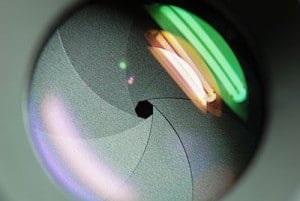
The aperture is a small set of blades in the lens that controls how much light will enter the camera. The blades create a octagonal shape that can be widened (we photogs call it shooting “wide open”), or closed down to a small hole. Obviously, if you shoot with the aperture wide open, then more light is allowed into the camera than if the aperture is closed down to only allow a tiny hole of light to enter the camera.
So suppose you take a picture that is too bright. How do you fix it? Simply choose a smaller aperture. Simple! Aperture sizes are measured by f-stops. A high f-stop like f-22 means that the aperture hole is quite small, and a low f-stop like f/3.5 means that the aperture is wide open.
Let's test your knowledge to make sure you have it down. If you take a picture and it's too dark at f/5.6, would you choose a lower f-stop number or a higher one? Yep! You'd choose a lower f-stop number, which opens up the aperture to let in more light. The size of the aperture controls more than the brightness or darkness of the picture, though.
The aperture also controls the depth-of-field. Depth-of-field is how much of the picture is sharp, and how much is blurry. If you want to take a picture of a person with a blurry background, you'd use shallow depth of field. If you want to take a picture of a sweeping mountain vista, you'd want to use a small aperture size (high f-stop number) so that the entire scene is in sharp focus. If you, like me, are more of a visual learner, then I think this graphic will help solidify the information about aperture. Take a minute and make sure you understand this info before moving on.

Shutter Speed
The shutter is a small “curtain” in the camera that quickly rolls over the image sensor (the digital version of film) and allows light to shine onto the imaging sensor for a fraction of a second. The longer the shutter allows light to shine onto the image sensor, the brighter the picture since more light is gathered. A darker picture is produced when the shutter moves very quickly and only allows light to touch the imaging sensor for a tiny fraction of a second. The duration that the shutter allows light onto the image sensor is called the shutter speed, and is measured in fractions of a second. So a shutter speed of 1/2 of a second will allow more light to touch the image sensor and will produce a brighter picture than a shutter speed of 1/200 of a second. So if you're taking a picture and it is too dark, you could use a slower shutter speed to allow the camera to gather more light.
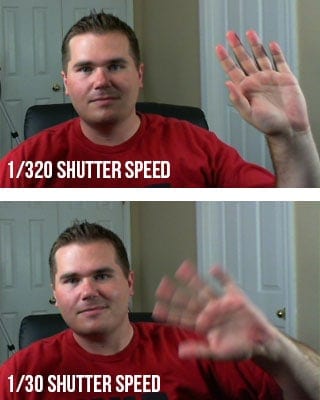
Just as the aperture affects the exposure as well as the depth-of field, the shutter affects more than just the exposure. The shutter speed is also principally responsible for controlling the amount of blur in a picture. If you think about it, it makes sense that the shutter speed controls how much blur is in the picture.
Imagine me sitting here at my computer desk waving to you (you don't have to imagine very hard if you just look at the picture on the right). If you take a picture of me with a shutter speed of 1/30th of a second, then my hand will have moved in the time that the camera is recording the picture. To get rid of the blur, you need to increase the shutter speed to around 1/320th of a second. At this speed, my hand is still moving, but the camera takes the picture so fast that my hand travels only such a small distance that it is not noticeable in the picture.
The next question that most people ask is, how slow of a shutter speed can you use and still get a sharp picture? My blog post on Minimum Shutter Speeds will answer your question!
ISO
The funny thing about ISO is that it is an acronym, but nobody really knows what it stands for. It is always just called ISO even though it really stands for International Organization for Standardization. Every once in a while, you'll hear an older photographer pronounce it “I-so”, but almost everyone pronounces it “I.S.O.” The ISO controls the exposure by using software in the camera to make it extra sensitive to light.
A high ISO such as ISO 1,600 will produce a brighter picture than a lower ISO such as ISO 100. The drawback to increasing the ISO is that it makes the picture noisier. Digital noise is apparent when a photo looks grainy. Have you ever taken a picture at night with your cell phone or your pocket camera, and noticed that it looks really grainy? That is because the camera tried to compensate for the dark scene by choosing a high ISO, which causes more grain.
What constitutes a “high” ISO is constantly changing. Camera companies are constantly improving the ability of cameras to use high ISOs without as much grain. A few years ago, only the highest-end pro DSLR cameras could achieve 2,000 ISO, and now even entry-level DSLR cameras can shoot at this level. Since each camera is different, you would do well to do a few tests with your camera to see how high of an ISO you can shoot at without making the image overly grainy.
Right now, you will commonly find new DSLRs that advertise expandable ISO ranges.
Putting It All Together
I know exactly what you're thinking. “Why do I need three tools to control the exposure? Wouldn't one suffice?” The answer is no, and I'll explain why with an example. In January, I took a trip to my favorite place on the planet to take pictures–Yellowstone National Park. My guide informed us that the bighorn sheep in the park were dying off very quickly due to whooping cough, so I worked hard that week to capture pictures of the last few sheep in that area of the park.
Around 9AM on a cloudy day, I found a small group of bighorn sheep and started photographing them with a long 600mm lens. The early hour and clouded sky made the situation quite dark for shooting.
Let me help you out. The lens I was working with cost around $12,000, but don’t worry. You can get really good results with a much more affordable 600mm lens. I’m considering selling my expensive lens.
Anyway, it had a maximum aperture size of f/4. So I set my aperture at f/4 to gather as much light as possible. This also impacted the depth-of field to blur out the rocks behind the bighorn sheep. Next, I set my shutter speed. I wanted to capture action in the photo, so I set my camera to 1/1000th of a second shutter speed. I knew that this fast of a shutter speed would prevent any motion blur from the sheep running on the mountain side. Then, I took a picture. WAAAY too dark! I couldn't compromise my shutter speed or aperture, so I knew I needed to use the third player in the exposure triangle–the ISO.
I played around with my ISO and found that if I increased it to ISO 640, it made the picture bright enough to take the picture without making it overly grainy. This combination of shutter speed, aperture, and ISO worked out perfectly. It feels so good to hone in the camera settings!
Now can you see why you need to know how to shutter, aperture, AND ISO, and know how to set them independently on your camera!
If you're a visual learner and want to really learn your camera, then be sure to check out my Photography Start Course. Just a reminder, it's a series of 22 videos where I take you on location to shoot waterfalls, landscapes, people, kids, and macro photos. You can look over my shoulder and see exactly how I set up my camera to take professional photos.
Now, you need to learn how to apply these settings on your camera to take advantage of your new-found nuggets of knowledge.

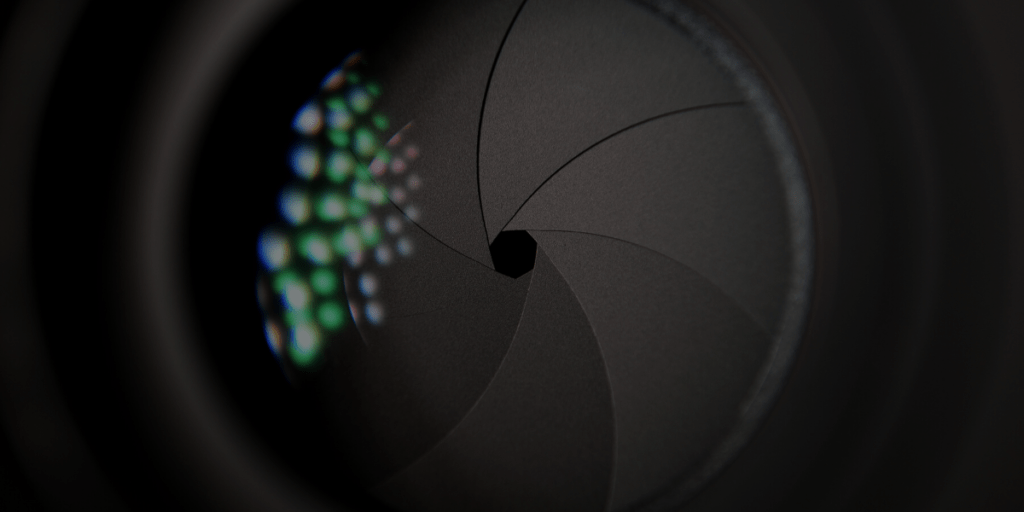


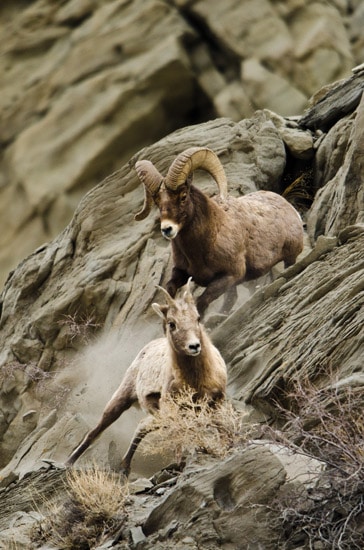
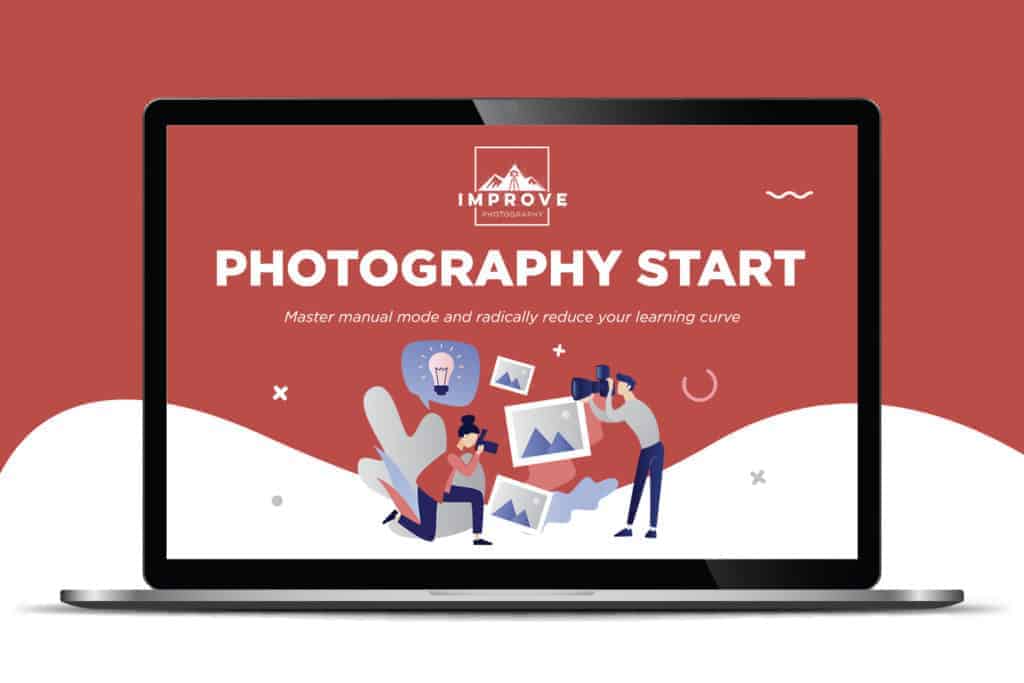
hy !
i bought hx400v sony ! but i m nt able to blur the backgroung !
can u tell me how to focus ?
Thank you so much for posting this article, really loved it and very useful, but still I have a question, do you intend to change the shutter, aperture, and ISO in specific order? If YES please explain.
@khalilhannahraimat:disqus
I always want the ISO to be the smallest number it can be, so I set it at 100 to start with (unless I can tell from experience the lighting is too low then I will start with 400 or 800). Then I have to decide if my emphasis is stopping motion vs. the depth-of-field. If I want to stop motion I may use shutter priority mode so that I can se the shutter speed and let the camera figure out the aperture. If I want to control the depth-of-field (either making sure everything is in focus or only the subject is in focus and the background is blurry) then I will use aperture priority mode and let the camera set the shutter speed. It just depends what shot you are trying to create.
Great question, I think I may do a Photo Taco episode on it!
Jeff Harmon
Thank you Jeff, I think this is you are totally right, instead to handle everything in Manual at once, sometimes when you in rush and you need this shot, you can’t make the precise decision unless you pick the suitable creative mode which suits the moment, as you said, if your interest is in getting the depth of field and focus, then you do this and let the camera do the rest, I’ll start adopt myself in using the creative modes more.
Yes, I encourage you to do an episode about it, beginners like me will appreciate it too much 🙂 Thanks again pal.
Khalil
Precisely explained all three controls, thanks for sharing!
I have been using a digital Nikon L810 but you can’t make very many adjustments with ISO or aperture and nothing with the shutter speed outside of the different modes. So my Dad fished out my Aunts old camera for me to experiment with – it is an old Olympus OM-G film camera. She had 4 lenses (35mm, 50mm, 100-200mm, and a 135 mm) I was wondering if the lenses can be used on a digital camera… the film is cool but I don’t like that I can’t see if I got a good picture or not. Any help with tips on use would also be greatly appriciated it did not have its manual and what I could look up is hard to understand consisting of mostly pictures and very little explination.
With some digital cameras that allow interchangeable lenses – yes you can (e.g. mirrorless Sony A6000, A6300, A7, A7M2). For example on Sony A7M2, I use my old (1960s) canon rangefinder film camera lenses (LTM39 screw mount) and my old (1960s) Nikon SLR film camera non-Ai, Ai, and Ai-S lenses (Nikon F-mount). I do need to use lens adapters to get the lenses adapted to the Sony camera E lens mount. Using these lenses means everything is manual, there is no auto-focus or auto aperture ability. I use Aperture Priority (A) and Manual (M) shooting modes and sometimes shutter priority (S) mode. But am definately not an experienced photographer.
Thank you so much for simplifying everything.
I really had a hard time relating the three elements together.
Been reading a lot of things and only on your post that I understand them clearly.
THANKS!
What a fantastic explanation. You are doing a really great job by creating this website which have useful tools and technique necessary for new photographers. There are millions of website on this subject but your explanation skills are best and user friendly. Keep it up.
Thanks
Sanjay
Dubai
Thank Q so much sir
Thankyou so much for the explanation. I couldnt get my head around these basic . I till here its been so simple to understand and surely will help in application.
Thankyou
Thank you very much for the information, can’t wait to go and take some pics
Wow really nice. Crystal clear explanations. Thank you for your guidance sir.
Nice explanation, I’ve read a few things and it’s hard to put the pieces together. This is clear and concise.
thanks yuo very much for your gaidance
Now this is exactly how an introduction to Photography should be. Precise, a pictorial depiction and sticking to the facts. The examples with actual numbers and their effects makes it all the more easy to understand. Thanks a ton.
Thank you so much for posting this article, really loved it and very useful, but still I have a question, do you intend to change the shutter, aperture, and ISO in specific order? If YES please explain.
No, there is no reason to change them in a specific order.
I haven’t explore the rest of site, but finally explaining these logic in lay man s term!! Great!!!!!!!
Hello Jim,
I am pretty new in photography. I have my Canon PowerShot 51Si that allows me to shot some pretty photos, but I think that I need a better one. Can you suggest me a good intermediate -advance camera? It is a mess when I read the posts between Canon, Nikon, Sony, Mirrorless, and so on. My two possible candidates are Canon and Nikon. I know the question is like asking which one is better Pepsi or Coke; it depends on each person. my budget is around US 1200 lenses included. Can I get a good one by this price? I have an small bakery business, and I have to take pictures of my products also, moreover, from time to time I like to take some photos in the forest, mountains and ocean. Thanks
I’d probably go for the Nikon D5500 with this kit lens. Then also get the Nikon 50mm f/1.8G lens. That’d be a GREAT kit to get started with.
Thanks Jim,
Without a doubt, I will go for these two recommendations.
Bye
Your lessons are awesome, this tutorial is far better than your sample photos (Amazing Photograph of Bighorn Sheep). I have book marked dozens of Sites for for these 3 vital aspects of photography ( App,Shutter speed and ISO). No body has explained so well about these in just one single shot. You have explained the same with very basic examples. With this any layman can become a professional. Amazing. Thank you so much.
This is what exactly have been looking for thanks alot.am, yet to improver more
You need to improver your english.
This is very simple to understand. Great job writing it!!! Thank you.
Thanks for giving me some knowledge about the camera
Nice name fam